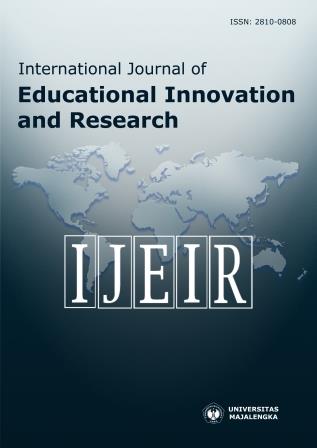Gender Differences in the Adoption, Usage, and Perceived Effectiveness of AI Writing Tools
A Study Among University for Development Studies Students
DOI:
https://doi.org/10.31949/ijeir.v4i1.11717Abstract
The purpose of this paper is to investigate gender differences in the adoption, use patterns and perceived effectiveness of AI writing tools by undergraduate students at the University for Development Studies (UDS). In light of the rapid adoption of AI tools into the landscape of higher education, it is important to examine male and female students as they relate to the usage and perceptions of AI in higher education. This study employs the Technology Acceptance Model (TAM) as a theoretical framework to explore how factors such as perceived ease of use, perceived usefulness, and attitudes toward technology influence AI adoption and usage patterns. A cross-sectional survey design was used for data collection using a structured questionnaire from 320 students across three departments. Statistical analyses (including t-tests and chi-square tests) were used to examine differences by gender. More than three-fourths (76.9%) of student respondents reported the use of AI tools, while 31.6% reported daily use. No significant differences were found between male and female students on perceived effectiveness, and both male and female students perceived AI tools as being effective. Results demonstrate the comorbid use of artificial intelligence in the academic writing context and imply that any gender differences in AI output are mitigated by the supportive capabilities of AI tools. The study's implications highlight the need for educators to provide equitable access and training in AI tools to support diverse student needs. Policymakers and developers should focus on designing inclusive AI writing tools that address potential barriers, ensuring all students benefit equally from technological advancements in education.
Keywords:
Adoption, Gender Difference, Effectiveness, Artificial Intelligence, Higher EducationDownloads
References
Abbasi, S., Ayoob, T., & Malik, A. (2020). Perceptions of students regarding E-learning during Covid-19 at a private medical college. Pakistan Journal of Medical Sciences, 36(COVID19-S4). https://www.ncbi.nlm.nih.gov/pmc/articles/PMC7306963/
Arowosegbe, A., Alqahtani, J. S., & Oyelade, T. (2024). Students’ Perception of Generative AI Use for Academic Purpose in UK Higher Education. https://doi.org/10.20944/preprints202405.1158.v1
Baum, S. (2021). Research Questions and Research Design. 11–27. https://doi.org/10.1007/978-981-16-1677-8_2
Burkhard, M. (2022). Student perceptions of AI-powered writing tools: towards individualized teaching strategies. 19th International Conference on Cognition and Exploratory Learning in Digital Age (CELDA 2022). https://www.grammarly.com/plagiarism-checker
Chanuan, U., Kajohnsak, C., & Nittaya, S. (2021). Sample Size Estimation using Yamane and Cochran and Krejcie and Morgan and Green Formulas and Cohen Statistical Power Analysis by G*Power and Comparisions. Apheit International Journal. https://so04.tci-thaijo.org/index.php/ATI/article/view/254253
Davis, F. D., & Granić, A. (2024). The Technology Acceptance Model. https://doi.org/10.1007/978-3-030-45274-2
Gasaymeh, A.-M. M., Beirat, M. A., & Abu Qbeita, A. A. (2024). University Students’ Insights of Generative Artificial Intelligence (AI) Writing Tools. Education Sciences, 14(10), 1062. https://doi.org/10.3390/educsci14101062
Goswami, A., Dutta, S., Goswami, A., & Dutta, S. (2015). Gender Differences in Technology Usage—A Literature Review. Open Journal of Business and Management, 4(1), 51–59. https://doi.org/10.4236/OJBM.2016.41006
Jackson, L. A., Ervin, K. S., Gardner, P. D., & Schmitt, N. (2001). Gender and the internet: Women communicating and men searching. Sex Roles, 44(5–6), 363–379. https://doi.org/10.1023/A:1010937901821
Keser, A. E. (2024). The promise and peril of AI technology for writing instruction: an exploratory study on stakeholder attitudes toward using AI tools in a university first-year writing program. The University of Alabama.
Khaleel, M., Jebrel, A., & Shwehdy, D. M. (2024). Artificial Intelligence in Computer Science. International Journal of Electrical Engineering and Sustainability (IJEES), 2(2), 1–21. https://doi.org/10.5281/zenodo.10937515
Kumar, R. (2019). Research Methodology : Steps by steps guide for begineers. Sage Publications Limited. https://books.google.com.my/books?hl=en&lr=&id=J2J7DwAAQBAJ&oi=fnd&pg=PP1&dq=research+methodology&ots=cvlpHFPIki&sig=dd019t5g5CKG55KWE9v7RHMp62s&redir_esc=y#v=onepage&q=research methodology&f=false
Li, N., & Kirkup, G. (2007). Gender and cultural differences in Internet use: A study of China and the UK. Computers and Education, 48(2), 301–317. https://doi.org/10.1016/J.COMPEDU.2005.01.007
Mishra, B., & Bhaskar, A. U. (2010). The learning enabling structure: Validating a measuring instrument. Indian Journal of Industrial Relations, 157-164.
Nysveen, H., & Pedersen, P. E. (2005). Explaining intention to use mobile chat services: moderating effects of gender. Journal of Consumer Marketing, 22(5), 247–256. https://doi.org/10.1108/07363760510611671
Schweigert, W. A. (2006). Research methods in psychology : a handbook. 316.
Selwyn, N. (2020). The Dilemmas of Critically Researching Technology and Education. Telling Tales on Technology, 159–170. https://doi.org/10.4324/9781138368736-11
Sevnarayan, K., & Potter, M. A. (2024). Generative Artificial Intelligence in distance education: Transformations, challenges, and impact on academic integrity and student voice. Journal of Applied Learning and Teaching, 7(1), 104–114. https://doi.org/10.37074/jalt.2024.7.1.41
Stöhr, C., Ou, A. W., & Malmström, H. (2024). Perceptions and usage of AI chatbots among students in higher education across genders, academic levels and fields of study. Computers and Education: Artificial Intelligence, 7. https://doi.org/10.1016/j.caeai.2024.100259
Tabachnick, B., Fidell, L., & Ullman, J. (2013). Using multivariate statistics. https://www.pearsonhighered.com/assets/preface/0/1/3/4/0134790545.pdf
Winkler, R., & Soellner, M. (2018). Unleashing the Potential of Chatbots in Education: A State-Of-The-Art Analysis. Academy of Management Proceedings, 2018(1), 15903. https://doi.org/10.5465/AMBPP.2018.15903ABSTRACT
Yilmaz, H., Maxutov, S., Baitekov, A., & Balta, N. (2023). Student Attitudes towards Chat GPT: A Technology Acceptance Model Survey. International Educational Review, 1(1), 57–83. https://doi.org/10.58693/ier.114
Yusuf, A., Pervin, N., & Román-González, M. (2024). Generative AI and the future of higher education: a threat to academic integrity or reformation? Evidence from multicultural perspectives. International Journal of Educational Technology in Higher Education, 21(1). https://doi.org/10.1186/s41239-024-00453-6
Published
How to Cite
Issue
Section
License
Copyright (c) 2025 Hassan Mubarik Iddrisu, Simon Alhassan Iddrisu, Bashiru Aminu

This work is licensed under a Creative Commons Attribution-ShareAlike 4.0 International License.









